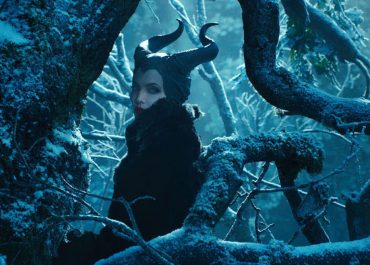“Well, well,” uttered Maleficent.
When Disney has nothing new to tell, they get prudent visions. They reinterpret both the 19th-century fairy tale and Disney’s 1959 The Sleeping Beauty. The surprising part is: Disney explores the sinister side of the tale by retelling the story from the view of its legendary villain Maleficent—who curses a baby with a miserable fate.
At the beginning (remember this), this film is crafted with witty and thoughtful script—credited to Disney’s talented Linda Woolverton (Beauty and the Beast, Lion King). As the story sees a tale from the wicked point of view, it provides our loving fairy Maleficent (Angelina Jolie) with shrewd motives to turn into a loathing wicked villain. Jolie’s portrayal of Maleficent is impeccable as she blurs the line of good and evil in this modern tale. But Jolie’s not alone; Young Maleficent (portrayed by Isobelle Molloy) is also attractive as she flies away with other fairies, nymphs, and creatures of the woods in a joyous moment.
Sentimental treachery—that’s too obvious to tell—has turned Maleficent into an evil fairy godmother you always see before. Fueled by her despise to her human foe, King Stefan (Sharlto Copley) whose tyranny blinds his own heart, Maleficent curses his daughter Aurora with her famous spell of sleep. As Maleficent watches over growing Aurora (Elle Fanning with her cartoonish look), twists and turns happen on both sides—intertwining them in a tale never told.
During the whole duration, the best part of Maleficent is, of course, the persona of this “evil” fairy portrayed by Jolie. Her character is both malevolent but magnificent; her acting and look are also fascinating. Her cheekbone and red lips, her pale skins and monstrous horns help Jolie to keep intimidating. The thing is, Jolie’s only menacing when she’s evil or conflicting. She manages well character transitions, yet, results in an awkward “good” side. She fits the role of villain best, but, not yet a decent protagonist. However, Jolie manages good chemistry with her raven sidekick, Diaval (Sam Riley)—at least, it helps her to stick to her dimensional role.
If it’s okay with Jolie as the center of attraction, I might say that Maleficent is troubled by its narrative—especially, just before the climax of the story. Strong and well-off conflict build-ups that we have during the first two acts are not self-sustained, as it turns out. An attempt of twisting and turning from the original story comes about a dragging moment that ruins the climax and, later, the whole third act. How visual-artist-turned-director Robert Stormberg “fails” the second half of this film is obvious when he’s imposing rash and simplified decisions to conclude the story. A question pops out: do we still need to avoid daring ending and play safe for every summer film? The answer is yes, for Maleficent.
All in all, Maleficent is still a decent Disney film and a prove of Disney’s successful visionary. With stable narrative in the beginning and short cut in the middle, Maleficent is simply aiming for a milder consequence to fits its PG rating. With various CGI creatures and over-orchestrated scoring, Maleficent might be an enlightening summer entertainment; although I frankly don’t get too impressed by them. However, Maleficent is not any good without Angelina Jolie.

[imdb style=”transparent”]tt1587310[/imdb]
TRIVIA: There’s a moment when Maleficent meets little Aurora. It’s not a coincidence, but little Aurora is portrayed by Vivienne Jolie-Pitt, Angelina Jolie’s own daughter, just because she doesn’t cry seeing “Maleficent.”


Leave a Reply